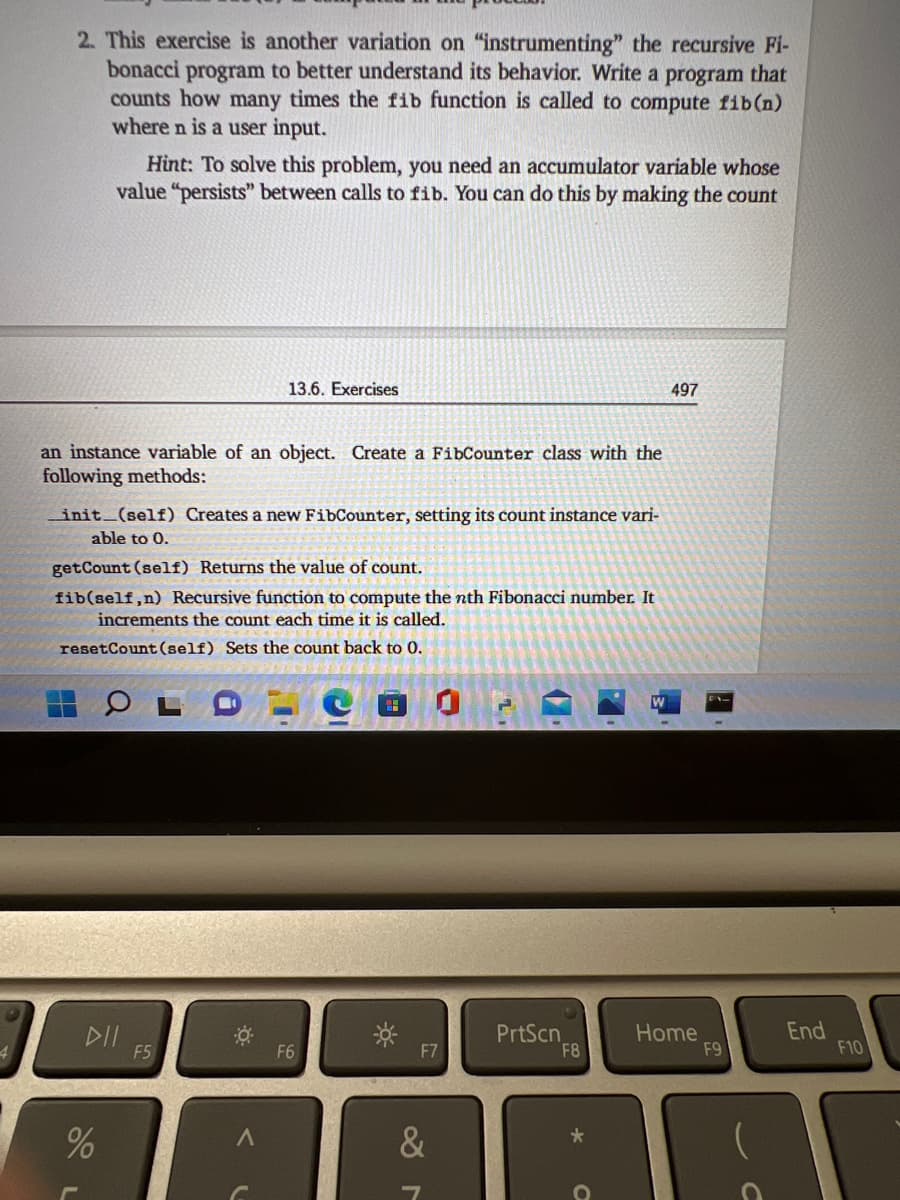2. This exercise is another variation on "instrumenting" the recursive Fi- bonacci program to better understand its behavior. Write a program that counts how many times the fib function is called to compute fib(n) where n is a user input. Hint: To solve this problem, you need an accumulator variable whose value "persists" between calls to fib. You can do this by making the count 13.6. Exercises 497 an instance variable of an object. Create a FibCounter class with the following methods: init (self) Creates a new FibCounter, setting its count instance vari- able to 0. getCount (self) Returns the value of count. fib(self,n) Recursive function to compute the nth Fibonacci number. It increments the count each time it is called. resetCount (self) Sets the count back to 0.
2. This exercise is another variation on "instrumenting" the recursive Fi- bonacci program to better understand its behavior. Write a program that counts how many times the fib function is called to compute fib(n) where n is a user input. Hint: To solve this problem, you need an accumulator variable whose value "persists" between calls to fib. You can do this by making the count 13.6. Exercises 497 an instance variable of an object. Create a FibCounter class with the following methods: init (self) Creates a new FibCounter, setting its count instance vari- able to 0. getCount (self) Returns the value of count. fib(self,n) Recursive function to compute the nth Fibonacci number. It increments the count each time it is called. resetCount (self) Sets the count back to 0.
C++ Programming: From Problem Analysis to Program Design
8th Edition
ISBN:9781337102087
Author:D. S. Malik
Publisher:D. S. Malik
Chapter15: Recursion
Section: Chapter Questions
Problem 8SA
Related questions
Question
Python

Transcribed Image Text:2. This exercise is another variation on "instrumenting" the recursive Fi-
bonacci program to better understand its behavior. Write a program that
counts how many times the fib function is called to compute fib(n)
where n is a user input.
Hint: To solve this problem, you need an accumulator variable whose
value "persists" between calls to fib. You can do this by making the count
13.6. Exercises
497
an instance variable of an object. Create a FibCounter class with the
following methods:
init (self) Creates a new FibCounter, setting its count instance vari-
able to 0.
getCount (self) Returns the value of count.
fib(self,n) Recursive function to compute the nth Fibonacci number. It
increments the count each time it is called.
resetCount (self) Sets the count back to 0.
DII
F5
PrtScn
F8
Home
F9
End
F10
F6
F7
Expert Solution
This question has been solved!
Explore an expertly crafted, step-by-step solution for a thorough understanding of key concepts.
This is a popular solution!
Trending now
This is a popular solution!
Step by step
Solved in 3 steps with 2 images

Knowledge Booster
Learn more about
Need a deep-dive on the concept behind this application? Look no further. Learn more about this topic, computer-science and related others by exploring similar questions and additional content below.Recommended textbooks for you

C++ Programming: From Problem Analysis to Program…
Computer Science
ISBN:
9781337102087
Author:
D. S. Malik
Publisher:
Cengage Learning

C++ Programming: From Problem Analysis to Program…
Computer Science
ISBN:
9781337102087
Author:
D. S. Malik
Publisher:
Cengage Learning